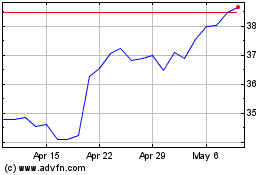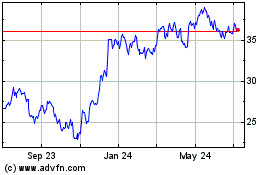Fifth Third Releases Results of 2017 Dodd-Frank Act Company-Run Capital Stress Test
June 22 2017 - 6:02PM
Business Wire
Fifth Third Bancorp (NASDAQ: FITB) today released the results of
its company-run stress test as required by the Dodd-Frank Act
Stress Test (DFAST) rules (12 CFR Part 252). These rules require
that covered companies disclose certain results from its stress
test including: a description of the types of risk included in the
stress test, a general description of methodologies used in the
stress test, estimates of certain financial results and pro forma
capital ratios, and an explanation of the most significant causes
for the changes in regulatory capital ratios. The results are
available on Fifth Third’s Investor Relations website at
http://ir.53.com by clicking on “Quarterly & Annual
Reports”.
Fifth Third Bancorp is a diversified financial services company
headquartered in Cincinnati, Ohio. As of March 31, 2017, the
Company had $140 billion in assets and operates 1,155 full-service
Banking Centers, and 2,471 ATMs in Ohio, Kentucky, Indiana,
Michigan, Illinois, Florida, Tennessee, West Virginia, Georgia and
North Carolina. Fifth Third operates four main businesses:
Commercial Banking, Branch Banking, Consumer Lending and Wealth
& Asset Management. Fifth Third also has a 17.8% interest in
Vantiv Holding, LLC. Fifth Third is among the largest money
managers in the Midwest and, as of March 31, 2017, had $323 billion
in assets under care, of which it managed $33 billion for
individuals, corporations and not-for-profit organizations through
its Trust, Brokerage and Insurance businesses. Investor information
and press releases can be viewed at www.53.com. Fifth Third’s
common stock is traded on the NASDAQ® Global Select Market under
the symbol “FITB.”
Forward-Looking Statements
This release contains statements that we believe are
“forward-looking statements” within the meaning of Section 27A of
the Securities Act of 1933, as amended, and Rule 175 promulgated
thereunder, and Section 21E of the Securities Exchange Act of 1934,
as amended, and Rule 3b-6 promulgated thereunder. These statements
relate to our financial condition, results of operations, plans,
objectives, future performance or business. They usually can be
identified by the use of forward-looking language such as “will
likely result,” “may,” “are expected to,” “anticipates,”
“potential,” “estimate,” “forecast,” “projected,” “intends to,” or
may include other similar words or phrases such as “believes,”
“plans,” “trend,” “objective,” “continue,” “remain,” or similar
expressions, or future or conditional verbs such as “will,”
“would,” “should,” “could,” “might,” “can,” or similar verbs. You
should not place undue reliance on these statements, as they are
subject to risks and uncertainties, including but not limited to
the risk factors set forth in our most recent Annual Report on Form
10-K as updated from time to time by our Quarterly Reports on Form
10-Q. When considering these forward-looking statements, you should
keep in mind these risks and uncertainties, as well as any
cautionary statements we may make. Moreover, you should treat these
statements as speaking only as of the date they are made and based
only on information then actually known to us. There is a risk that
additional information may become known during the company’s
quarterly closing process or as a result of subsequent events that
could affect the accuracy of the statements and financial
information contained herein.
There are a number of important factors that could cause future
results to differ materially from historical performance and these
forward-looking statements. Factors that might cause such a
difference include, but are not limited to: (1) general economic or
real estate market conditions, either nationally or in the states
in which Fifth Third, one or more acquired entities and/or the
combined company do business, weaken or are less favorable than
expected; (2) deteriorating credit quality; (3) political
developments, wars or other hostilities may disrupt or increase
volatility in securities markets or other economic conditions; (4)
changes in the interest rate environment reduce interest margins;
(5) prepayment speeds, loan origination and sale volumes,
charge-offs and loan loss provisions; (6) Fifth Third’s ability to
maintain required capital levels and adequate sources of funding
and liquidity; (7) maintaining capital requirements and adequate
sources of funding and liquidity may limit Fifth Third’s operations
and potential growth; (8) changes and trends in capital markets;
(9) problems encountered by larger or similar financial
institutions may adversely affect the banking industry and/or Fifth
Third; (10) competitive pressures among depository institutions
increase significantly; (11) changes in customer preferences or
information technology systems; (12) effects of critical accounting
policies and judgments; (13) changes in accounting policies or
procedures as may be required by the Financial Accounting Standards
Board (FASB) or other regulatory agencies; (14) legislative or
regulatory changes or actions, or significant litigation, adversely
affect Fifth Third, one or more acquired entities and/or the
combined company or the businesses in which Fifth Third, one or
more acquired entities and/or the combined company are engaged,
including the Dodd-Frank Wall Street Reform and Consumer Protection
Act; (15) ability to maintain favorable ratings from rating
agencies; (16) failure of models or risk management systems or
controls; (17) fluctuation of Fifth Third’s stock price; (18)
ability to attract and retain key personnel; (19) ability to
receive dividends from its subsidiaries; (20) potentially dilutive
effect of future acquisitions on current shareholders’ ownership of
Fifth Third; (21) declines in the value of Fifth Third’s goodwill
or other intangible assets; (22) effects of accounting or financial
results of one or more acquired entities; (23) difficulties from
Fifth Third’s investment in, relationship with, and nature of the
operations of Vantiv Holding, LLC; (24) loss of income from any
sale or potential sale of businesses (25) difficulties in
separating the operations of any branches or other assets divested;
(26) losses or adverse impacts on the carrying values of branches
and long-lived assets in connection with their sales or anticipated
sales; (27) inability to achieve expected benefits from branch
consolidations and planned sales within desired timeframes, if at
all; (28) ability to secure confidential information and deliver
products and services through the use of computer systems and
telecommunications networks; and (29) the impact of reputational
risk created by these developments on such matters as business
generation and retention, funding and liquidity.
You should refer to our periodic and current reports filed with
the Securities and Exchange Commission, or “SEC,” for further
information on other factors, which could cause actual results to
be significantly different from those expressed or implied by these
forward-looking statements.
View source
version on businesswire.com: http://www.businesswire.com/news/home/20170622006271/en/
Fifth Third BancorpSameer Gokhale (Investors), 513-534-2219Larry
Magnesen (Media), 513-534-8055
Fifth Third Bancorp (NASDAQ:FITB)
Historical Stock Chart
From Mar 2024 to Apr 2024

Fifth Third Bancorp (NASDAQ:FITB)
Historical Stock Chart
From Apr 2023 to Apr 2024
